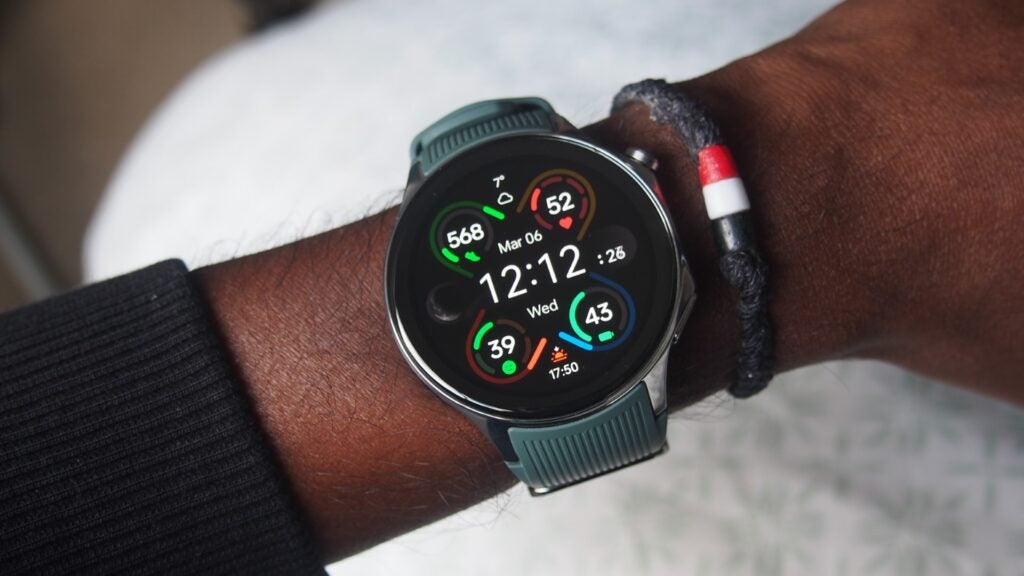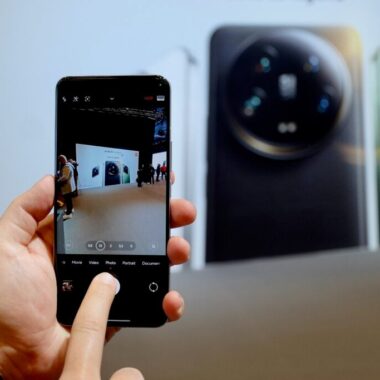Verdict
The OnePlus Watch 2 pushes the battery boundaries for Wear OS, which is a big win for OnePlus and for the Google platform as a whole.
Pros
- Good battery life (with raise to wake)
- Slick WearOS skin
- Good sports and fitness tracking features
Cons
- While it is well-made, it doesn’t stand out from the crowd
- Battery life with always-on screen isn’t great
- Heart rate readings during exercise aren’t the most accurate
-
Runs on wearOS 4.0 and RTOSThe OnePlus Watch 2 is one of few watches to run not one but two operating systems to extend battery life -
Up to 100 hours of battery lifeDepending on the mode you’re in, the OnePlus Watch 2 can last up to 100 hours on a single charge. -
Dual-frequency GPSDual-frequency GPS allows for more accurate positional tracking when exercising, even in built-up areas.
Introduction
The OnePlus Watch 2 is the brand’s second attempt at making a smartwatch, and it’s fair to say that, based on its efforts with the original OnePlus Watch, it had plenty of work to do.
When the first OnePlus Watch launched in 2021, it competed with smartwatches that sat below the ultra-high-level Apple Watch and Samsung Galaxy Watch. While elements like the display, battery life, and UI were highlights, there were far more lowlights, and it was buggy at launch.
So, OnePlus is back, with a new operating system approach, a new price, and new hope that it has fully learned from its past mistakes.
Design and screen
- Sticks to 46mm case
- Higher resolution AMOLED screen
- Waterproof up to 50 metres
With the OnePlus Watch 2 priced higher than the first watch, I expected OnePlus to up things in the design department.
Let’s start with what hasn’t changed. You still only have a 46mm case option to pick from, which comes in black steel or radiant steel looks and lacks some unisex appeal based on its size and colour options.
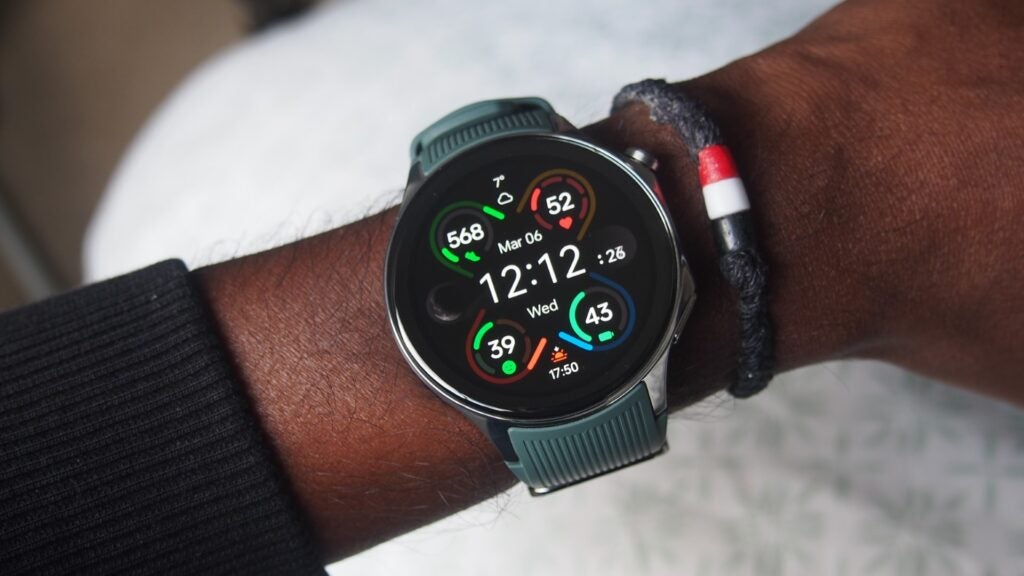

At 12.1mm thick, or 13.65mm if you include the PPG sensor around the back, it’s chunkier than the first Watch, weighs in more (80g compared to 67g-76g) and sticks to a stainless steel case material, which gives the watch some weight.
OnePlus has ditched the bad strap on the first watch for a fluoroelastomer one that uses a more traditional watch buckle, making it a lot easier to get on and off. It’s a 22mm removable strap as well too, so if you want to swap out that band, the simple pin mechanism makes it easy to do.
OnePlus says the design of the Watch 2 has been inspired by stopwatches and automobiles, with the former represented by flattening one of the case edges. This gives it a slightly more unique look, but I can’t help but think it still doesn’t really hugely differ from similar smartwatch looks offered by Huawei and Mobvoi. It’s clearly well-made, but it’s not a look that’s at all memorable, either.
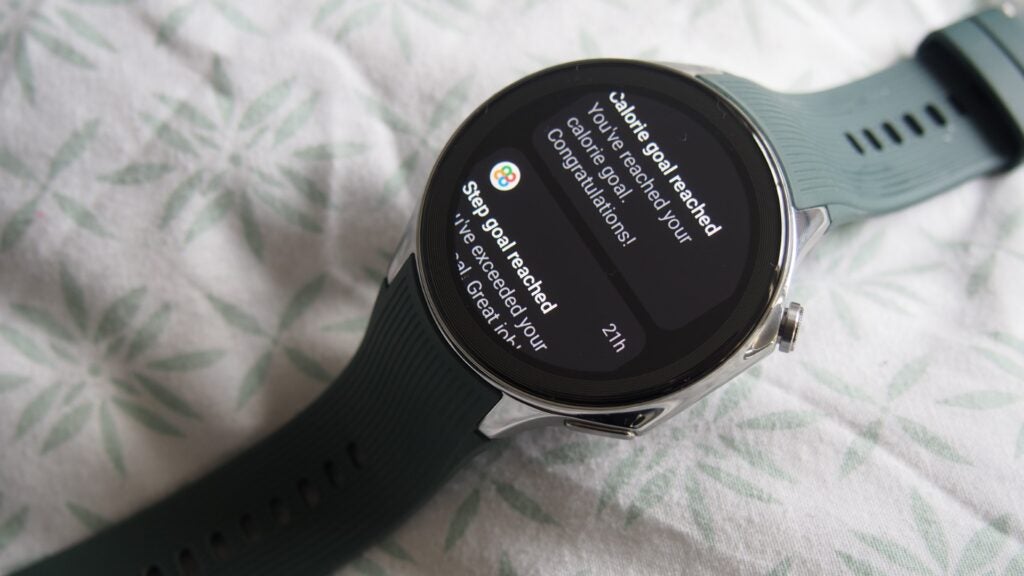

In terms of navigating the watch, there are two physical buttons, with the top one a twisting kind that actually doesn’t put that twisting to work to let you scroll through the software. The bottom flatter button is your shortcut to the sports tracking menu, something we’ve seen adopted by other smartwatches.
You’re getting a 1.43-inch, 466 x 466 AMOLED display to take care of everything else. That’s the same size display as the first Watch, though there is a bump in resolution. The display was a strong quality one on the original and it’s more of the same here. It’s sharp, colours are accurate, viewing angles are generally good outside, it’s nicely responsive to taps and swipes and this time an always-on mode is available at launch.
OnePlus hasn’t moved on the waterproof rating, so this is a watch that can survive being submerged in water up to 50 metres thanks to a 5ATM-rated design. I’ve taken it swimming and can confirm it’s fit to live in the water. It additionally packs an IP68 rating to protect it against dust and has the necessary military-grade certifications to handle high and low temperatures, being dunked in sand and can handle high impact if you plan to get rough and ready with it.
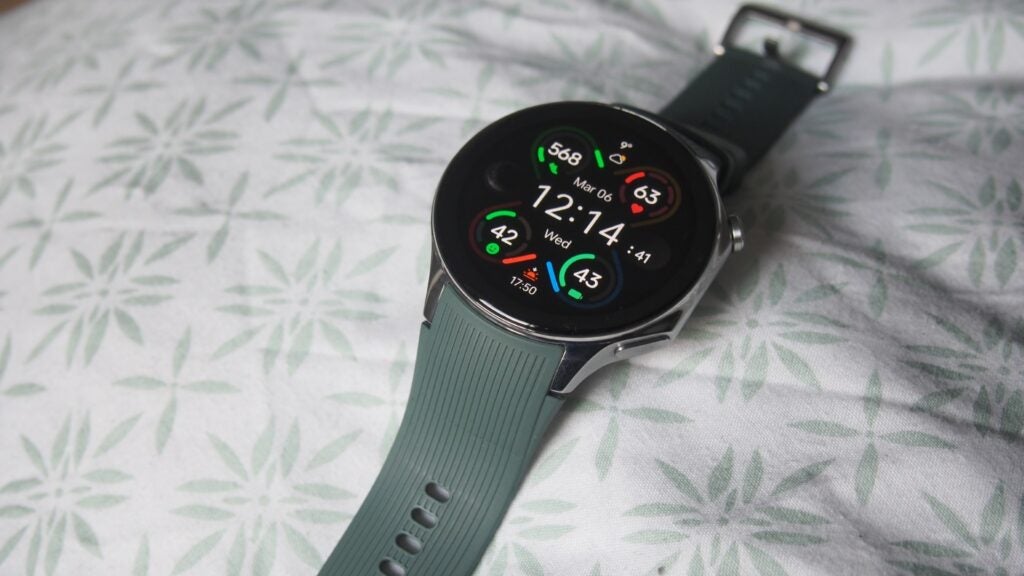

Performance and software
- Works with Android only
- Runs on WearOS and RTOS
- Powered by co-processor setup
For the first OnePlus Watch, OnePlus opted to use an RTOS-based operating system, similar to what fellow smartwatch brands like Amazfit use. This typically leads to slick-running software and noticeably stronger battery life compared to full-fat smartwatches. While it did deliver on those aspects, it ultimately lacked in many other departments on the performance front.
With Watch 2, we’re still getting an RTOS OS, but you’re also getting WearOS 4.0 thrown into the mix. That means access to Google’s apps, with some of those apps preloaded on the wearable.
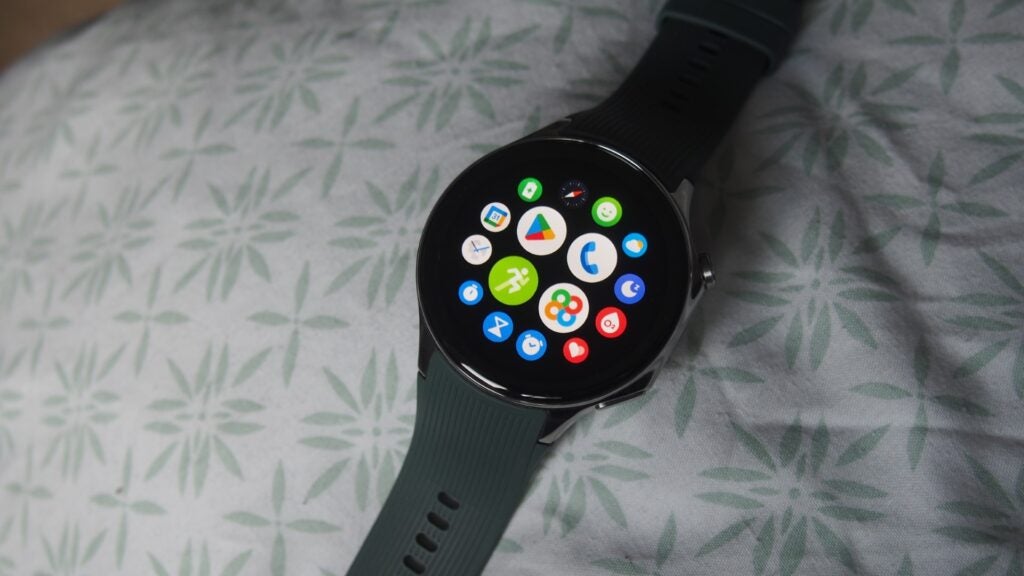

In addition to having two operating systems, there are also two chipsets. Essentially, you’re getting Qualcomm’s Snapdragon W5 chipset to take care of Wear OS tasks like mapping and streaming music, for instance, and a BES2700 chip for tasks like displaying notifications and is called upon when the always-on mode is activated. This has some ramifications for battery performance, which I’ll get into later.
In terms of that software experience, OnePlus adds its own UI, which is likeable on the whole. There’s a nice collection of watch faces, the widgets are nicely optimised for the high-quality display, and invariably, there are Wear OS elements like viewing calendar appointments and weather forecasts.
OnePlus treats the app drawer UI slightly differently from the way Google and Samsung do, where you can pinch to display the names of app icons, which is a nice solution to keeping the UI clean until you need to know what you want to interact with.
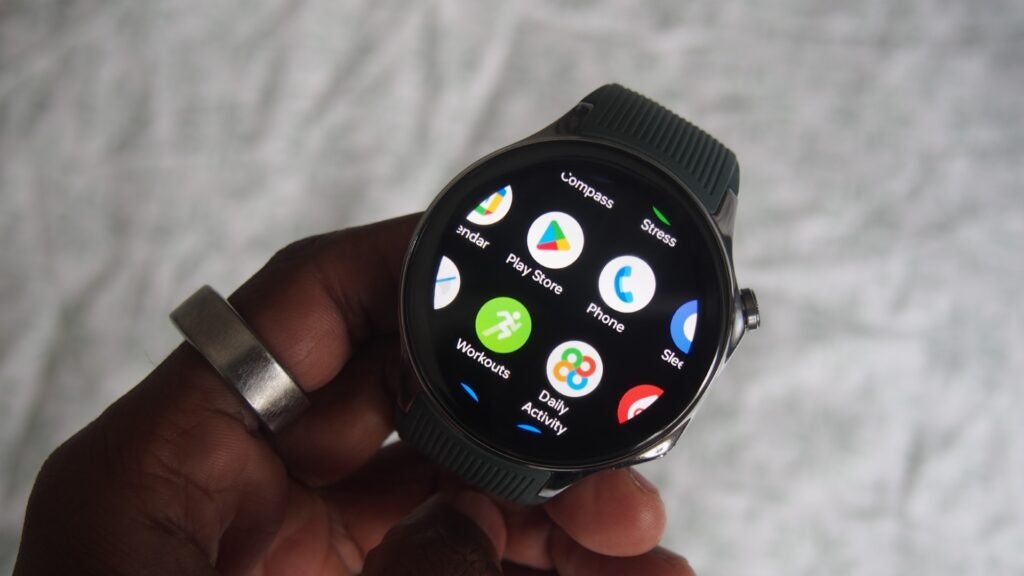

Adding Google’s apps into the mix is a major plus. Having an app store that lets you add in big-name apps, payment support that works and mapping and navigation support instantly makes the Watch 2 more useful to have around.
The notification support works well, and there’s a portion of the 32GB storage to pile audio onto. Support for apps like Spotify makes it quick to download offline playlists (if you have a Premium account) and makes it worth pairing up your Bluetooth headphones to it—or playing it out loud if you’re that kind of person.
Setting up the watch is done via the OHealth Android app, which once again means no love for iPhone users. This app dishes out your health and fitness stats on one screen, lets you track workouts via the phone from another and also lets you change watch faces and Tiles (widgets), as well as do actions like syncing calendar events. It’s a nicely presented app in general and keeps things simple in places where simplicity is certainly welcomed and needed.
Tracking and features
- Dual-band frequency GPS included
- Additional metrics for runners, badminton and skiing
- Tracks sleep, heart rate and stress
Like most smartwatches, OnePlus knows you like to track your steps, runs, sleep and everything else in between. So it aims to cover most of those bases.
It promises over 100 sports modes, with running, badminton and skiing getting extra activity-specific metrics. There are sensors on board to track steps and detect sleep, an optical sensor to capture heart rate, stress and SpO2 data, and the addition of a dual-frequency GPS mode. This promises to boost outdoor tracking accuracy like other dual-band watches from the likes of Apple, Huawei and select Garmin watches among others.
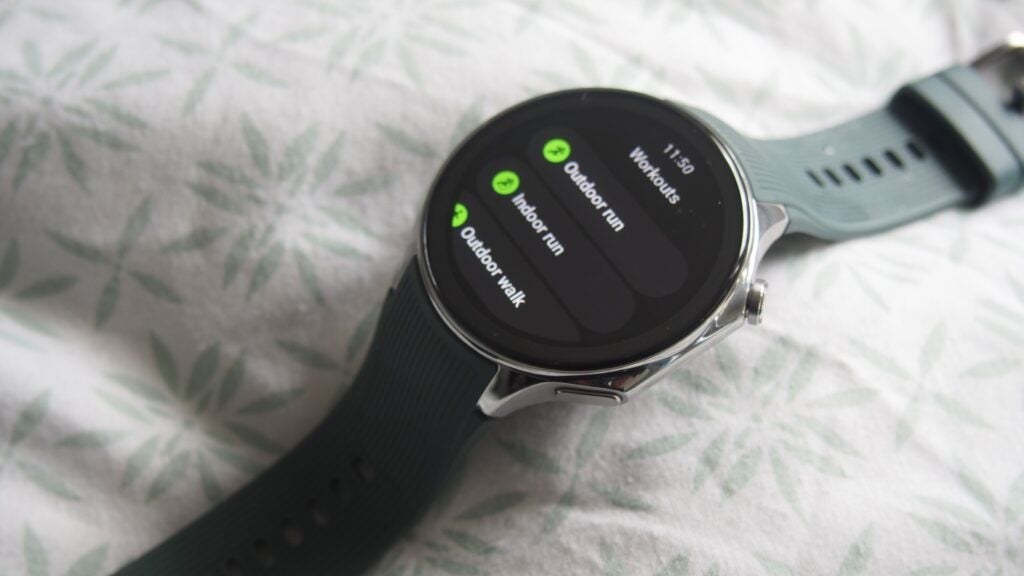

As a day-to-day fitness tracker, OnePlus adopts four rings to display daily step count progress, calorie burn, inactivity stamps and exercise time. It’s perhaps not as slick as Apple’s rings, but does give you something to quickly glance at during the day to gauge progress. I’ve been wearing it alongside a few other fitness trackers, and daily step counts were typically within 500-800 steps of the other trackers, so I’d say I was pretty satisfied with performance, and step counts never felt wildly out.
For sleep tracking, you’ll get a nice summary both on and off the watch, covering time slept, sleep stage breakdowns including REM sleep, a sleep score and it’ll additionally monitor breathing patterns, respiratory rate and heart rate ranges.
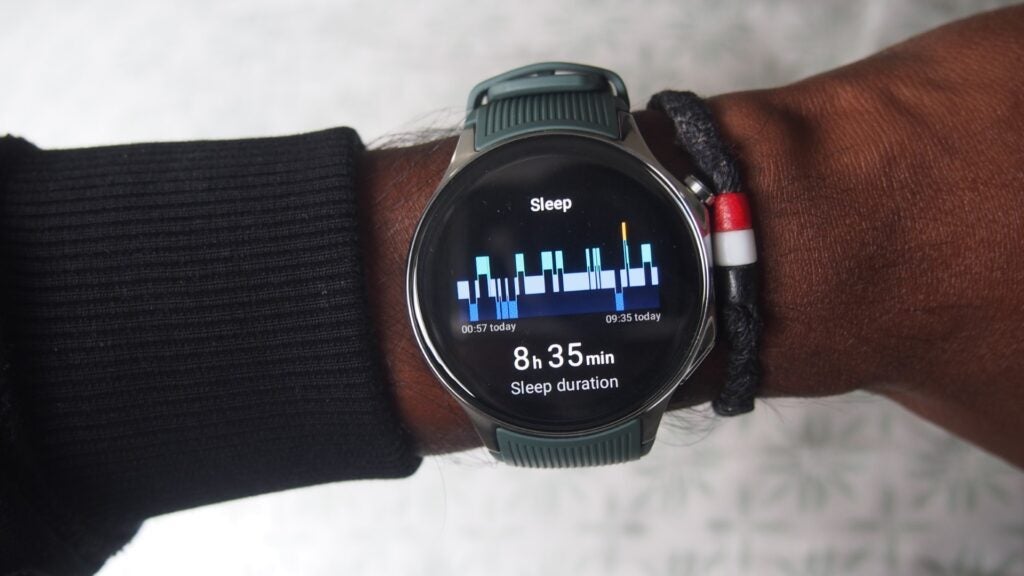

I’ve been taking it to bed with the Oura Ring Gen 3 and found that there was generally a 30-minute difference between sleep duration though both produced similar sleep scores. Sleep stage breakdowns generated similar deep sleep and REM numbers, though there were some bigger differences with light sleep recorded on some nights. Heart rate data ranges and resting heart rate did feel reliable, too, so the sleep tracking felt good overall.
Switching to sports tracking mode, I’ve run indoors and outdoors, used it in the pool and for general indoor workouts like indoor rowing. I put the dual-frequency GPS to the test against a Garmin watch with similar support and found that distance tracking was short, and looking at the mapped routes in the app showed that part of the route wasn’t captured.
On an indoor run, tracking was 4km off from another watch, and the difference was so big on my first run that it made it challenging to calibrate it to improve accuracy. Comparing additional run metrics like average ground contact time and vertical oscillation, the numbers reported across the two watches never matched, though they weren’t wildly off either and seemed to tell a similar story about my running form.
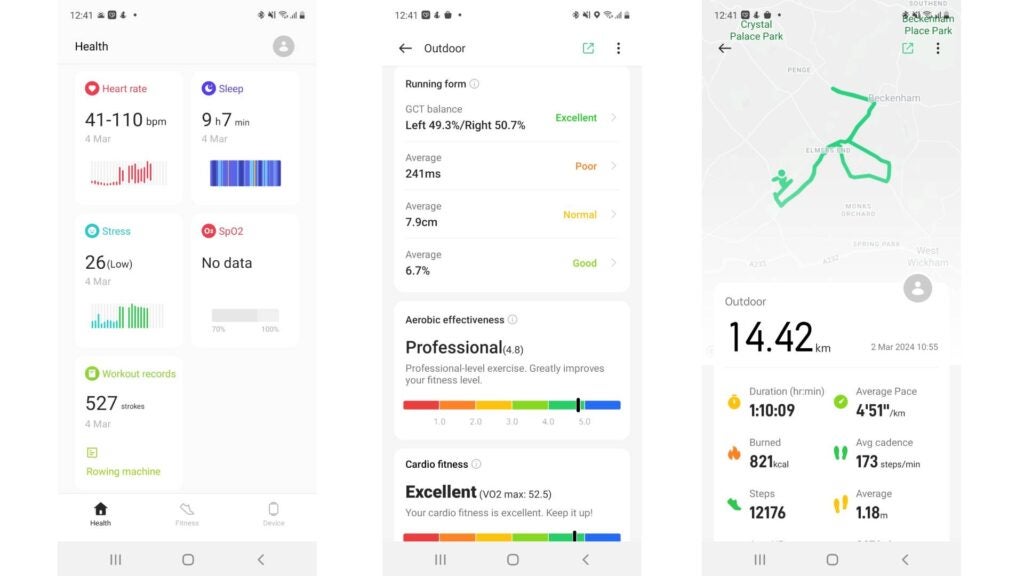

Heart rate tracking during exercise wasn’t great at all times. Up against a Polar H10 heart rate monitor chest strap, average heart rate readings at times could be anywhere from 8-10 bpm out from a chest strap. For maximum heart rate, it was worse and could be up to 20 bpm off a chest strap. Monitoring heart rate during the day and night outside of exercise generally felt more reliable, so if you’re not putting it to more vigorous use, you might be happy with that heart rate performance.
In the pool, I used it against a Garmin watch and the excellent Form Swim Goggles and found it came up a few lengths short of the other two devices for lap counts. It also clocked me at a slower average pace, though average SWOLF and calorie burned numbers were similar at least.
I think there are aspects of fitness and sports tracking that work fine, but it does ultimately fall into that bracket of smartwatches that aren’t going to better what you’ll get from a dedicated sports watch.
Battery life
- Up to 100 hours (4 days) in smartwatch mode
- Up to 2 days in always-on mode
- Power save mode gives you 12 days
Battery life is a big story for the OnePlus Watch 2. Its first watch promised up to 14 days of battery life, and it could achieve that largely because it was running a less power-sapping operating system. Now that WearOS 4 is in the mix, it’s promised to push the boundaries of what a Google-powered smartwatch can deliver on the battery front.
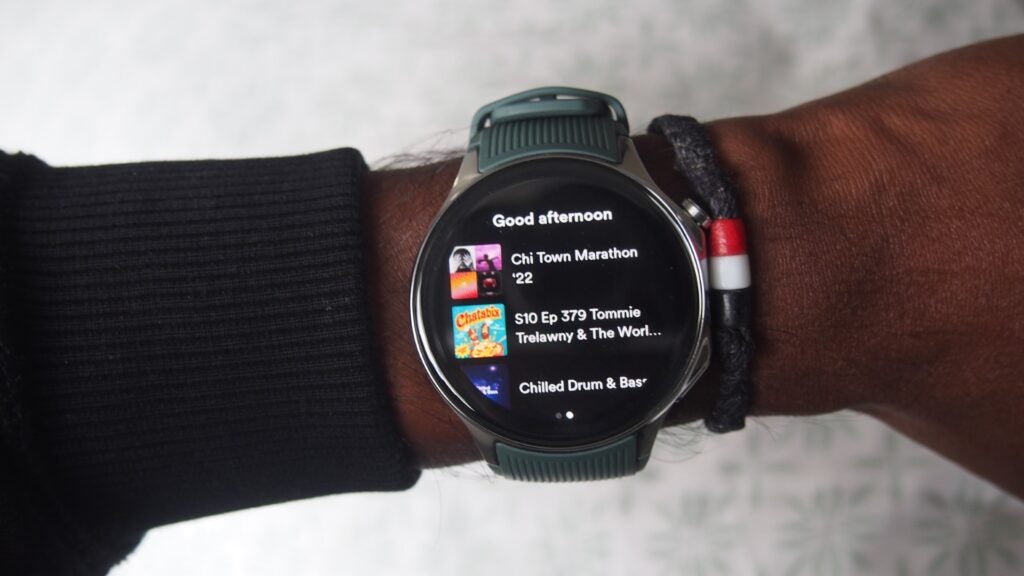

The 500mAh battery can deliver up to 100 hours (4 days) in smartwatch mode, though I should add that this doesn’t factor in keeping the screen on at all times. If you opt for the 24/7 screen option, then that number drops to two days, and you’ll be notified when you turn that mode on.
In addition, there’s a power-saving mode, which promises up to 12 days in which you’ll still be able to receive notifications, track your fitness (without route tracking), and do things like continuously track your heart rate.
In that smart mode, OnePlus uses both chipsets, while in heavier usage, the Snapdragon side of this dual setup is used.
If you’re using this watch in what OnePlus here deems smartwatch mode, I’ve found that daily drop-off can be anywhere from 20-25%. It was typically higher on days I used the GPS, which is to be expected. When I switched the screen to always-on, the battery drop was noticeably more severe, and I only got 1-2 days from it.


So, if you compare that smart mode performance against other Wear OS smartwatches, like the Samsung Galaxy Watch 6 and the TicWatch Pro 5, which offers up to 80 hours in a similar mode, OnePlus really pushes things forward here.
The power-saving mode impressed me as well. When the battery was running low and I switched to the power-saving mode first thing in the morning, I managed to get through a day of use, including tracking an indoor workout, and it was still running the following day.
When you do need to charge, it supports fast charging from the proprietary charging cradle, getting you 0-100% from an hour of charging. The battery performance is solid overall, and you’ll certainly be charging it less than other Wear OS watches.
Should you buy it?
You want the best Wear OS smartwatch for battery life
The approach of packing two operating systems and chipsets pays off here: The OnePlus Watch 2 has the best battery of any Wear OS smartwatch.
You want the best smartwatch for serious health tracking
If you care about having a smartwatch to track your heart rate, particularly during exercise, or if you want medical-grade tracking, there are better smartwatch options out there.
Final Thoughts
This is a much better effort than OnePlus’ first smartwatch, and the decision to embrace two operating systems and chipsets really pays off here. Bringing Google into the fold without having to contend with a short battery is a big kudos to OnePlus for making it work without sacrificing performance.
It’s not a perfect smartwatch in every aspect, but there’s plenty here to make it a good one to have on your wrist at a price that does make it a worthy Android-only alternative to the Samsung Galaxy Watch 6 and also a good alternative to Huawei’s smartwatch clan.
FAQs
Yes, the OnePlus Watch 2 can make calls when connected to your phone. It doesn’t have LTE or any sort of cellular connection support to make standalone calls.
The OnePlus Watch 2 has a battery life of up to 100 hours (4 days) in smartwatch mode. That drops to two days with the screen set to always-on, and there’s a power saving mode that will give you up to 12 days of battery.

